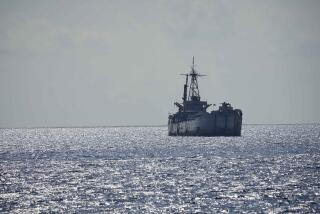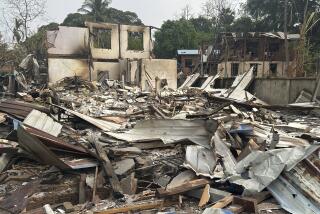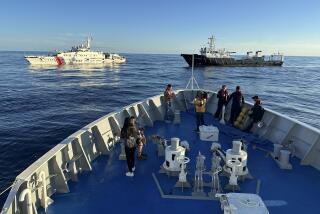Army and Rebel Clashes Intensify in Philippines
- Share via
ISABELA, Philippines — The voice, tense and urgent, crackled over Capt. Harold Cabunoc’s radio with the news that fighting had begun.
“It’s ongoing! It’s ongoing!” came the raw-edged words from the battle zone Thursday.
As the Philippine army officer called for an estimate of enemy strength, four U.S. Special Forces soldiers and three Philippine servicemen scrambled aboard a jeep and headed off hurriedly.
The latest battle with Islamic rebels was underway along this remote front of America’s global war against terrorism--the southern Philippine island of Basilan.
Under the rules of the mission, U.S. forces can advise, assist and train Philippine units but are not supposed to engage in direct combat. They may shoot in self-defense, but there was no indication that Americans came under fire while helping rescue Philippine forces in Thursday’s clash.
The encounter with members of the Muslim extremist group Abu Sayyaf began about five miles west of Isabela, the provincial capital, around midmorning and continued until well after dark. Philippine military authorities described it as one of the most intense battles in recent months with the rebel group.
One Philippine officer involved in the fighting claimed that the troops had encountered parts of the Abu Sayyaf’s main group of fighters, including those holding U.S. hostages Martin and Gracia Burnham. The Abu Sayyaf is also holding a Philippine nurse, Deborah Yap. There were also reports that garments, apparently belonging to Gracia Burnham, were recovered from the scene of the initial fighting.
Philippine military sources said late Thursday that their forces killed at least three rebels in the firefight but that more bodies might be found today. Seven Philippine soldiers were reportedly wounded in the fighting and were evacuated with U.S. help to a hospital in the city of Zamboanga on the nearby large island of Mindanao.
Thursday’s fighting marked the latest in a series of deadly skirmishes between Philippine forces and the Abu Sayyaf. With four rebels dead in fighting earlier this week and an unknown number killed in heavy fighting last Friday, the results of Thursday’s encounter make it an especially costly week for the extremist guerrilla group.
Philippine military officials estimated that the total Abu Sayyaf strength on Basilan--700 fighters at its peak slightly more than a year ago--was down to between 80 and 100 rebels before the recent spate of fighting began. A far larger group of several hundred Abu Sayyaf fighters is believed to be on the nearby island of Jolo.
Many here view the fighting of the last week as a clear sign that momentum in the decade-old struggle to crush the Abu Sayyaf is clearly beginning to swing in the government’s favor.
“We are not allowing them to rest,” declared army Col. Alexander Aleo, commander of the estimated 3,500 Philippine armed forces deployed on Basilan. “I’m expecting a series of new encounters in the days ahead.”
U.S. Special Forces Lt. Col. David Maxwell said, “Things are going well.”
Both officers were interviewed at a military headquarters complex in a jungle clearing on the outer fringes of Isabela just before the outbreak of Thursday’s fighting.
The extremists, whose political demands include the expulsion of all Christians and the creation of an Islamic state in the southern region of the country, have more recently become notorious for resorting to kidnappings as a way to finance their struggle. Yap and the two American missionaries are only the latest in a series of victims seized by the rebels in recent years.
The U.S. government claims that the group has links with the Al Qaeda terrorist network.
Philippine authorities have failed to crush the Abu Sayyaf since it first launched its campaign of terror in the southern region a decade ago, but the arrival of 660 U.S. Special Forces in the country last month has visibly changed the balance of the fight, according to military and civilian sources in the area.
Such an assessment is surprising considering that only 160 Americans are deployed on Basilan itself and the rules governing their deployment limit their movement in combat situations. Still, the technology that U.S. forces have brought with them, including high-tech aerial surveillance equipment that can track enemy movements beneath the island’s thick jungle canopy even at night, has been pivotal in locating rebel groups.
“The numerous encounters of recent days is the result of American intelligence,” said Maj. Noel Detoyato, a Philippine armed forces spokesman based in Zamboanga. “We can track where these guys go now, where they retreat.”
Detoyato and other Philippine officers said the U.S. ability to evacuate wounded soldiers by helicopter even at night had boosted troop morale enormously.
“They know that even if they are wounded at night, their chances of survival is great,” he said.
That capability was demonstrated in the early hours Saturday, when a seriously wounded Philippine soldier was evacuated from a battle zone on Basilan to a hospital in Zamboanga in only 10 minutes.
“Before, we would have had to evacuate him by boat, and that would have taken so long the soldier probably would have died,” said Aleo, the Philippine army colonel.
There are also signs that the rebels are weakening.
Aleo noted that most encounters are now with relatively small groups of rebels, an indication that the Abu Sayyaf’s leaders have decided to divide their followers into more mobile bands to evade the increasingly intense pursuit. Aleo also said there is evidence that the guerrillas, who once received supplies by boat from neighboring islands, are now sending relatives to buy supplies in local markets.
“We’re blockading them,” Aleo said. “Their supply lines have been cut off.”
An additional indicator of the group’s predicament came in the body count that followed Monday’s encounter: One of those killed in the fighting was said to be 13.
More to Read
Sign up for Essential California
The most important California stories and recommendations in your inbox every morning.
You may occasionally receive promotional content from the Los Angeles Times.













